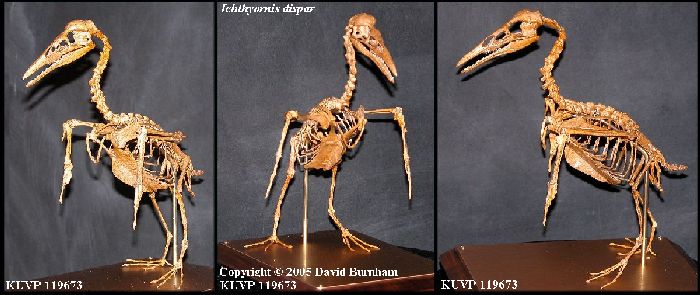 |
Ichthyornis dispar:
A toothed, flying bird from the Late Cretaceous of
Kansas
Copyright © 2003-2012 by Mike Everhart
Created 11/23/2003: Last updated 07/05/2012
LEFT: Cast of KUVP 119673 mounted in a dynamic
take-off pose by Anthony Maltese (Photo taken 2010). |
Latest news: Some of the earliest bird remains in North America were
reported in 2011 from north central Kansas by Alyssa Bell and Mike Everhart:
Bell
, A.
and Everhart, M.J. 2011. Remains of small ornithurine birds from a
Late Cretaceous (Cenomanian) microsite in
Russell
County, north-central Kansas. Kansas
Academy
of Science, Transactions 114(1-2):115-123.
Abstract: Our
analysis of vertebrate remains collected from a Cenomanian microsite in the
Lincoln Limestone, the basal-most member of the Greenhorn Formation in Russell
County, Kansas, identifies ornithurine (sensu
Chiappe, 1996) avian fossils. The specimens presented here are slightly
younger than the oldest avian remains known from North America (from the
Woodbine Formation,
Texas
) and of a similar age as the avians from the Asheville Formation in
Saskatchewan
,
Canada
. This find thus connects the extensive geographic range of the earliest North
American birds from
Saskatchewan
south through central
Kansas
and on to
Texas
. The specimens discussed here are fragmentary, yet show features definitive of
ornithurine birds. One specimen is attributable to Ichthyornis,
whereas another preserves teeth characteristic of ornithurine birds. In addition
to bird bones, the microsite yielded numerous bony fish remains, shark teeth,
coniasaur vertebrae, and other lizard bones.
The limb bone and two small tooth bearing jaw fragments shown in
following photographs were collected from a calcarinite matrix from a 1-3 cm layer at the base of the Lincoln Limestone Member of
the Greenhorn Limestone Formation (marine, Upper Cretaceous) in Russell County, Kansas.
The jaw fragments
apparently came from the same specimen but do not fit together. The teeth are flattened, with
expanded bases, and are set in definite sockets. In appearance, the teeth are very
similar to those of the toothed
bird, Ichthyornis, but are somewhat smaller. Most of the vertebrate remains
found to date in this locality are shark teeth, including Squalicorax falcatus, Cretoxyrhina mantelli,
Cretalamna appendiculata, and several Ptychodontids. There also micro-vertebrate
teeth of various sharks present: (Carcharias amonensis,
Scyliorhinus sp. and Rhinobatos incertus). The teeth of bony fish such as
Enchodus, Ichthyodectes ? and Xiphactinus are also present,
along with a prearticular of a pycnodont, similar to
this one (Micropycnodon kansasensis). Several small reptile vertebrae have
been found and are attributed to Coniasaurus. A similar fauna was described
by Liggett, et al., (1997). The age is earliest Late Cenomanian. The basal Greenhorn
rests non-conformably on the Middle Cenomanian age Graneros Shale.
 |
LEFT: The
proximal end of a left coracoid, FHSM VP-17459), is identified as avian by
its strut-like shape and localized facets for the articulation of the
scapula and humerus. It is further assigned to the clade Ornithuromorpha
(sensu Chiappe 2002) by the placement of the humeral articular facet well
ventral to the acrocoracoid process. The presence of a prominent, medially
projecting acrocoracoid process identifies the coracoid as belonging to
the Ichthyornithes (Marsh 1873). Due to the fragmentary nature of the
fossil further definitive diagnosis is not possible.
FHSM VP-17459, proximal end of left coracoid in
dorsal (A), medial (B), lateral (C), and ventral (D) views. Label
abbreviations are as follows: Acr - acrocoracoid process, Gln - glenoid
facet, F Sup - supracoracoid foramen, Proc - procoracoid process, Scp -
scapular cotyle, S Sup - supracoracoid sulcus.
|
 |
LEFT: Both
fragments of FHSM VP-17461 contain one tooth. Both teeth are conical and
non-serrated. FHSM VP-17461a (Fig. 3a), a fragment of maxilla with a
single tooth, measures 1.15 mm from the tip of the crown to the medial jaw
line and is only very slightly recurved. FHSM VP-17461b (Fig. 3b), another
fragment of mandible with a single tooth, measures 1.22 mm from the
tip of the crown to the medial jaw line and is fully recurved. Both jaw
fragments are similarly shaped. On the lateral surface the upper edge of
the jaw is curved convexly, whereas the lower is concave. On FHSM
VP-17461a, a series of foramina are visible in the concave portion of the
jaw, whereas one is visible in a similar location on FHSM VP-17461b. The
medial surface of the jaw fragments bear a longitudinal groove along the
bottom edge and a noticeable bulge around the insertion of each tooth. The
top margin of FHSM VP-17461b appears to contain a narrow groove into which
the tooth is set, however this may be only due to crushing, as this area
is better preserved in FHSM VP-17461a and shows a smooth, rounded top of
the jaw on either side of the tooth.
FHSM VP-17461a (A) and -17461b (B), two fragments of
left/right? maxilla / mandible? in medial (A, C) and lateral (B, D) views.
Abbreviations are as follows: f - foramen.
|
 |
LEFT: The
proximal end of a right femur, FHSM VP-17458, has been extensively crushed
and preserves only the caudal face of the bone. The head of the femur is
separated from the shaft by a distinct neck. The medially-facing surface
of the head possesses a depression for the capital ligament proximally
offset on the face. Although the trochanter of the femur is not preserved
due to crushing, it appears to have risen to a similar proximal height as
the head of the femur. A shallow depression separates the head from the
trochanter. A faint groove runs longitudinally down the center of the
shaft, the proximal extent of which is obscured by breakage. Due to the
extensive crushing little else can be observed, however the shaft of the
femur does not appear to taper from the proximal end to the distal-most
end.
FHSM
VP-17458, proximal end of right femur in cranial view. Abbreviations are
as follows: CL - fovea for the capital ligament, H - femoral head, Tr -
trochanter. Only the cranial view is shown due to the heavy crushing and
distortion of the femur in other views. |
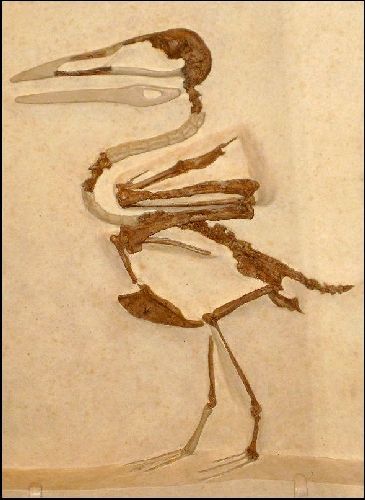 |
The first remains of a toothed bird from the Smoky Hill Chalk were collected in
the summer of 1872 by Professor B. F. Mudge, then a professor
at the Kansas State Agricultural College (KSAC, now Kansas State University, Manhattan,
KS) . Williston (1898) noted "that Professor Mudge
found the remarkable specimen of Ichthyornis, from the North Fork of the Solomon,
which furnished to the world the discovery of the then startling fact of birds with
genuine teeth." It was a small, very delicate specimen, contained in a slab of chalk,
and, while it eventually created considerable excitement, it also led initially to a bit
of confusion. It is worth noting here that although the holotype of Hesperornis had also been described in 1872 by Marsh from
collections made by him and his 1871 Yale College Scientific Expedition, the type specimen
was without a skull and the fact that it also had teeth was unknown at the time Ichthyornis
was found.
Although there are a fairly large number of
Ichthyornis specimens known, the most complete was collected in the 1990s
by Greg Winkler and Pete Bussen. The remains were donated to the
University of Kansas where they were prepared and mounted by David Burnham
and students at the Museum of Natural History. The specimen was initially
mounted in a standing pose (RIGHT). Subsequently, additional casts were
made by Triebold Paleontology (ABOVE) and assembled by Anthony
Maltese.
LEFT: Photograph of the original
reconstruction of Ichthyornis victor (dispar) in the collection of the
Yale Peabody Museum.
RIGHT: Photograph by David Burnham
of the reconstruction Ichthyornis dispar (KUVP 119673). Used with permission.
|
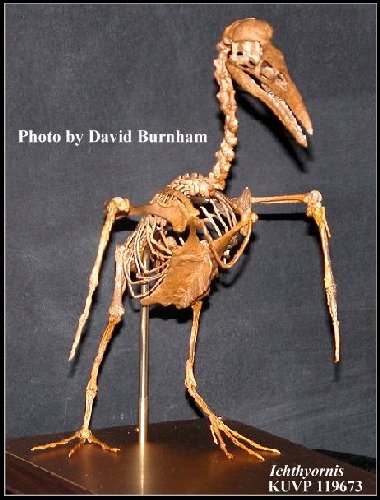
|
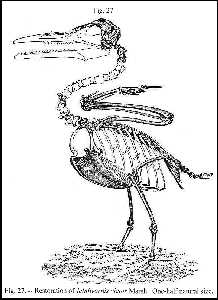 |
As was the custom at the time, Mudge had been sending his better
specimens to well-known paleontologists on the East Coast for examination and
identification. In previous years, he had sent most of his material to E. D. Cope. In an
1870 letter (Williston, 1898, p. 29-30), Cope
complimented Mudge on the scientific value of the material he had sent, and named a
"new species" of mosasaur (Liodon mudgei) after him. In fact, many of the
new species of fish and mosasaurs described by Cope between 1869 and 1872 were from the
specimens sent to him by Mudge (Everhart, 2002; 2005). Cope (1872) had also visited Mudge in late 1871 and examined his
collection in Manhattan, KS. However, it was a letter (Williston, 1898a) from O. C. Marsh
a year later that initiated a chain of events that would deny a spectacular specimen to
Cope, and give his rival, Marsh, the honor of describing the first toothed bird from the
chalk. LEFT: Fig. 27, a reconstruction of Ichthyornis
"victor", from Marsh, 1883. (CLICK TO ENLARGE). As reported by Clarke
(2004), this drawing was made from a composite of many specimens. (Note that Ichthyornis
victor is a junior synonym of I. dispar) |
Class:
Aves
Order: Ichthyornithiformes
Family: Ichthyornithidae Marsh,
1873
Genus: Ichthyornis Marsh,
1872
Species: I. dispar |
According to Williston, (1898a), on September
2, 1872, Marsh wrote to Mudge "inquiring about his summer collections in the
Cretaceous, with the offer to "determine any reptilian or bird remains without
expense," and stating that he would give him "full credit" for their
discovery." At the time, Mudge had a shipment already prepared to send to Cope.
Apparently, he changed his mind at the last moment, and sent the specimens instead to O.
C. Marsh for examination.
Williston (1898a) related the following story
of what had occurred: "An incident related to me by Professor Mudge
in connection with this specimen is of interest. He had been sending his vertebrate
fossils previously to Professor Cope for determination. Learning through Professor Dana
that Professor Marsh, who as a boy had been an acquaintance of Professor Mudge, was
interested in these fossils, he changed the address upon the box containing the bird
specimen after he had made it ready to send to Professor Cope, and sent it instead to
Professor Marsh. Had Professor Cope received the box, he would have been the first to make
known to the world the discovery of "Birds with Teeth."
Upon seeing the unusual specimen, Marsh quickly realized that he was looking at
the skeleton of a small bird that was very different from his newly discovered Hesperornis. The skull, however, was apparently missing
and Marsh recognized what he thought were the lower jaws of a small reptile in the same
block of chalk.
Williston (1898a) noted that Marsh wrote to Mudge again on September 25,
acknowledging the receipt of a box of fossils, and stating that the "hollow bones are
part of a bird, and the two jaws belong to a small saurian. The latter is peculiar, and I
wish I had some of the vertebræ for comparison with other Kansas species." Having no
additional remains available at the time (or at least not recognizing them), Marsh
concluded that Mudge's specimen actually represented the co-mingled remains of two new
species. Later that year, he briefly described and named Ichthyornis
dispar in the American Journal of Science, (1872b, p. 334). The name Ichthyornis
means "fish bird," reflecting the bi-concave,
"fish-like" vertebrae found in the remains.
While the records of the Yale Peabody collection indicate that the remains (YPM
1450) came from the Niobrara Formation of Scott County (which didn't even exist as an incorporated county in 1872), it is more likely that
Mudge collected them much further to the east (Williston, 1898; Peterson 1987, p. 231).
Walker (1967, p. 61) noted that the slab containing the bird remains came from an exposure
"on Bow Creek in northwestern Rooks County," a tributary of the Solomon River.
Parris and Echols (1992) reported that the type locality was Section 1, T6S, R19W in Rooks
County. This locality about 75 miles (120 km) from the closest chalk in what is now
northeast Scott County.
Later in the same year, Marsh (1872) followed with another brief note, describing and
naming a new species of marine reptile: Colonosaurus Mudgei.
By the following January, however, Marsh (1873a) had realized his mistake and published
his first paper on "birds with teeth." In March,
Marsh (1873b, p. 230) described Ichthyornis as, "A bird, about as large as a
Pigeon, and differing from all known birds in having teeth and biconcave
vertebrae [emphasis by Marsh]. The known remains were found in the Upper Cretaceous
shale of Kansas, and are preserved in the collection of Yale College." Hesperornis was mentioned in the same note but without
any indication that Marsh was then aware that it also had teeth. Colonosaurus, the
new genus based on the jaws of the little reptile that wasn't, was left to die a quiet
death. Williston, (1898a), mentioned it again briefly in
Volume IV of the Geological Survey of Kansas.
In a brief report on Kansas geology, Mudge (1877)
noted that "fossil birds were rare and valuable findings. These were generally of the
order Odontonadæ, or birds with teeth. They were of two genera; in one, the teeth being
placed in sockets, like mammalia, and in the other, in grooves, like many genera of fish
and reptiles. Several newer species were added to science, and more perfect specimens of Hesperornis were collected the past summer than ever
before. Perhaps it may not be amiss to add that birds with teeth have been found only in
the United States, and one genus, the Ichthyornis [sic], only in Kansas. Thus, our fossil pterodactyls have no teeth, and our birds have, in
direct contrast with those found in other parts of the world."
 |
The teeth and manner of their replacement were described in:
Marsh, O. C., 1883. Birds with Teeth. 3rd Annual Report of the Secretary of the
Interior, 3: 43-88. Government Printing Office, Washington, D.C., page 73: |
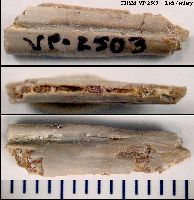 |
"In the lower teeth of Ichthyornis, the pulp-cavity
passes well up into the base of the crown. The fang is compressed, and directed downward
and forward. It is firmly set in a deep socket, which it nearly or quite fills. The dental
succession took place vertically, as in Crocodiles and Dinosaurs; not laterally as in Hesperornis
and the Mosasaurs, a fact of no little significance. The young teeth are much inclined
when they first appear above the jaw, after the old teeth have been expelled."
Marsh, 1883. LEFT: Fragment of the left dentary of FHSM VP-2503 in
medial, dorsal and lateral views, anterior to the right, showing the bases of three broken
teeth and two replacement teeth (second and fourth alveoli from the left) that were in the
process of emerging when the bird died. (See additional tooth bearing fragments of the
right dentary below) |
Gingerich (1972) reported on a new specimen of an Ichthyornis jaw that
he found in the Yale Peabody collection. He wrote, "I recently discovered an
additional mandibular fragment of Ichthyornis (I cf. dispar)
which was catalogued together with the bones of a specimen of the much larger Cretaceous
bird Hesperornis (YPM 1478) in the Yale Peabody Museum collection. This new
mandibular fragment of Ichthyornis is the only known specimen revealing the
morphology of the quadrate articulation. It presumably was collected together with YPM
1478, which was collected by B. F. Mudge from the Upper Cretaceous Niobrara Chalk, Wallace
County, Kansas in 1876. The new mandibular fragment is now catalogued as YPM 6264."
Unfortunately, little new information has been added to the list of known specimens of
toothed birds from Kansas since Williston's (1898b) summary of the bird collections made
by the University of Kansas. At that time, Williston reported a few new specimens have
been collected, but no where near the number found when Marsh made them a priority for his
field workers.
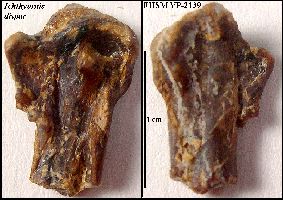 |
LEFT: M.V. Walker (1967) mentioned the discovery of the earliest
known Ichthyornis in Kansas... a fragment of a wing bone (the proximal end of the
right carpometacarpus; FHSM VP-2139) collected near the contact of the upper Greenhorn
Limestone and Fairport Chalk Member of the Carlile Shale (Middle Turonian) in southern
Ellis County, Kansas. (See also Martin and Stewart, 1977, 1982; Clarke, 2004; and Shimada
and Fernandes, 2006). Partially because of their small size and
fragility, they are less likely to be preserved. Bird fossils remain rare and elusive.
Putting things into a personal perspective, I've collected fossils in the Smoky Hill Chalk
since 1969 and the only Ichthyornis (FHSM VP-15574) remains I have ever found is a
1/2 inch (11 mm) fragment of a upper limb bone (coracoid - below) from Gove County in
2002... and the only reason that I found it was that I was down on my hands and knees
looking for shark teeth. |
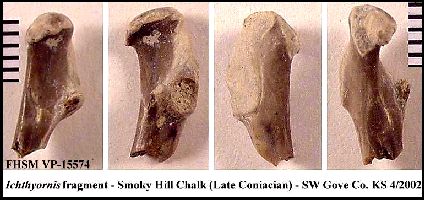 |
LEFT: Proximal end of a right Ichthyornis coracoid
(FHSM VP-15574) that I collected in 2002. RIGHT: Three views of a
nearly complete right coracoid of Ichthyornis dispar (FHSM VP-17317), collected
and donated by George Klein. |
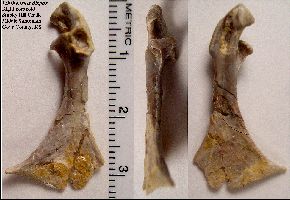 |
FHSM VP-2503 is a fairly complete specimen of Ichthyornis dispar,
including portions of the lower jaws, that was collected by J. D. Stewart in eastern
Graham County in 1970 (see Martin and Stewart, 1977). The locality is within a few miles
of the original site where B.F. Mudge collected the first
specimen in 1872. The specimen is currently on exhibit in the Sternberg Museum of Natural
History, Hays, Kansas (below).
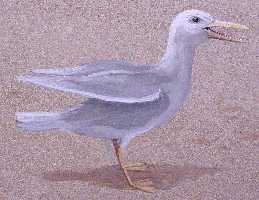 |
LEFT: A painting of Ichthyornis sp. in the seashore mural
at the Sternberg Museum of Natural History, based on skeletal remains (about 10
inches). Ichthyornis dispar was believed to be a small, gull or tern-like
bird with teeth. Additional picture HERE.
A recent paper by Hieronymus and Witmer (2010) suggests that
the tooth-bearing bones of Ichthyornis (and Hesperornis)
would not have been covered with a horny (keratinous) sheath; rather the
premaxilla, maxillae and the dentaries would have been covered with skin
and scales or feathers, giving it a more primitive, reptile like
appearance. RIGHT: A
mounted partial skeleton at the Sternberg Museum (FHSM VP-2503). The specimen was
collected by J.D. Stewart and others on August 9, 1970 (in Graham County, near Bogue, KS),
and brought to M.V. Walker at the Sternberg Museum for identification. |
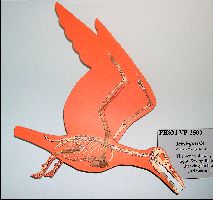 |
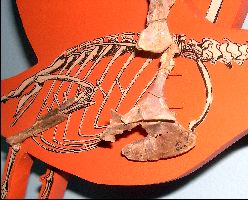 |
LEFT: The bones of the right shoulder girdle
of Ichthyornis dispar (VP-2503) shown in articulation. RIGHT: A drawing
for the skull of Ichthyornis dispar (VP-2503) in right lateral view with two
tooth bearing fragments of the lower right jaw shown in place. |
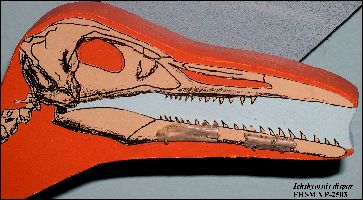 |
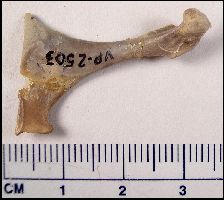 |
Some parts of the skeleton, including neck vertebrae, are stored in the
collection and not on display: LEFT: The left coracoid of FHSM VP-2503 (above right) at
the Sternberg Museum of Natural History.
RIGHT: The left humerus of FHSM VP-2503. According to Clarke (2004), limb elements are
the most frequently collected bird material in the Smoky Hill Chalk. |
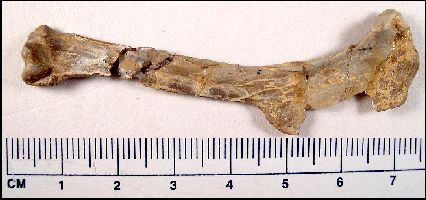 |
Another nearly completed (minus most of the skull) Ichthyornis specimen was
found by Greg Winkler and Pete Bussen in northern Lane County in the early 1990s. The
specimen (KUVP 119673) was donated to the University of Kansas Museum of Natural History
where it was recently prepared and is currently under study. According to Dr. Larry
Martin, it is the most complete specimen of Ichthyornis dispar ever found. The
preparation and reconstruction of the specimen was the
subject of paper presented by David Burnham at the 2005 annual meeting of the Society of
Vertebrate Paleontology (Mesa, AZ).
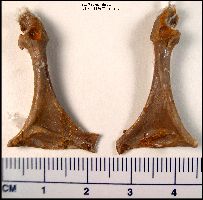 |
LEFT: Right and left coracoids of Ichthyornis dispar
(KUVP 119673). RIGHT: Two views of a complete humerus of Ichthyornis dispar
(KUVP 119673), |
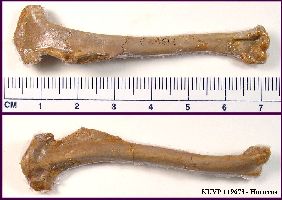 |
 |
In birds, the bones of the ankle (tarsals) are fused to form a
single element called the tarsometatarsal. The toes are connected to the distal end of the
tarsometatarsal. LEFT: A drawing of the reconstructed foot of Baptornis,
a Late Cretaceous swimming bird, showing the tarsometatarsal.
RIGHT: The distal end of the the right tarsometatarsal of Ichthyornis
dispar (FHSM VP-2179), a much smaller, flying bird. For a drawing of the feet of Ichthyornis
dispar from O.C. Marsh, GO HERE. |
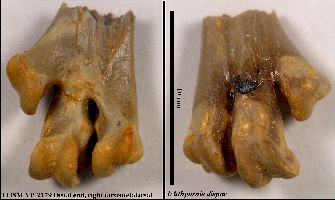 |
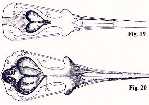 |
LEFT: Bird brains: In this figure from Marsh's (1883) Birds
with Teeth, the skull and relative brain size of Ichthyornis victor
(Fig.19 ) is compared with the modern Sandwich Tern (Sterna contac, Fig. 20). |
As Marsh (1883) noted, "the remains of birds are among the rarest of
fossils." Complete bird skeletons are extremely rare in the Western Interior Sea.
Because of their smaller size and relatively light construction, most bird bones would be
destroyed long before having the chance to become fossilized. Most of the material in
museum collections consists of a few parts or just a single bone. Like other extinct
animals, it is thus difficult to know with any certainty what these birds were like and
how they lived. Ichthyornis had strong wings and a well-developed keel (breastbone)
for anchoring flight muscles. Chinsamy, et al. (1998) noted that was "generally
accepted that Ichthyornis used its long jaws and recurved teeth for scooping fish
from surface waters (as gulls and terns scoop fish from surface waters today)." While
that is certainly a strong possibility, the another method of feeding that would be better
suited for jaws with teeth might be diving and pursuing prey underwater, much like is seen
in modern sea birds like shearwaters, guillemots and puffins. Such a scenario might also
explain the occurrence of the remains of these relatively small birds in the chalk. One
thing, however, is fairly certain. Ichthyornis and the other toothed, flying birds
found in the chalk were apparently capable of remaining in the air for long periods of
time and flying hundreds of miles.
Clarke (2004) re-studied the collection of Ichthyornis fossils at the
Yale Peabody Museum and reduced the 6 species named by Marsh
to one: Ichthyornis dispar Marsh 1872 (I. agilis, I. anceps, I.
tener, I. validus, and I. victor are all junior synonyms of I. dispar).
Among her other findings regarding the 81 specimens in the Yale Peabody Museum
collection, she concluded that Apatornis celer is a valid species and she found a
single specimen of a new species. In addition, she inventoried Ichthyornis bones
that were in the collection and found that wing bones (humerus and coracoid) were found
most frequently, along with leg bones. Her interpretation was that the limbs would
be the first pieces to fall off of a decomposing carcass.
Both ichthyornids and hesperornids are now regarded as unsuccessful
side-branches in avian evolution. In spite of superficial similarities to extant birds,
they have no modern relatives. While the number of specimens collected since the first
remains were found by Marsh and Mudge increases but slowly, research into these
fascinating toothed birds continues.
Suggested references:
Bell
, A. and
Everhart, M.J. 2011. Remains of small ornithurine birds from a
Late Cretaceous (Cenomanian) microsite in
Russell
County, north-central Kansas. Kansas Academy
of Science, Transactions 114(1-2):115-123.
Burnham, D. 2005. Transfer preparation of an
Ichthyornis specimen from the Niobrara Formation. Journal of Vertebrate
Paleontology 25(Supplement to 3): 41A.
Chinsamy, A., L. D. Martin and P. Dodson, 1998. Bone
microstructure of the diving Hesperornis and the volant Ichthyornis from
the Niobrara Chalk of western Kansas. Cretaceous Research 19:225-235.
Clarke, J. A. 2004. Morphology, phylogenetic taxonomy, and systematics of Ichthyornis
and Apatornis (Avialae: Ornithurae). Bulletin of the American Museum of Natural
History 286: 1-179.
Cope, E. D.
1872. Note of some Cretaceous
vertebrata in the State Agricultural College of Kansas. Proceedings of the American
Philosophical Society 12(87):168-170.
Everhart, M. J. 2002. New data on cranial measurements
and body length of the mosasaur, Tylosaurus nepaeolicus (Squamata;
Mosasauridae), from the Niobrara Formation of western Kansas. Kansas Academy of Science,
Transactions 105(1-2):33-43.
Everhart, Michael J. 2005. Oceans of Kansas - A Natural History of the
Western Interior Sea. Indiana University Press, 320 pp. (Chapter 11)
Fox, R.C. 1974. A middle Campanian, nonmarine
occurrence of the Cretaceous toothed bird Hesperornis Marsh. Canadian
Journal of Earth Sciences 11:1335-1338.
Fox, R.C. 1984. Ichthyornis (Aves) from the early Turonian (Late
Cretaceous) of Alberta. Canadian
Journal of Earth Sciences 21:258-260.
Galton, P. M. and Martin, L. D. (2002): Enaliornis,
an Early Cretaceous Hesperornithiform bird from England, with comments on other
Hesperornithiformes. 317-338. In: Chiappe, L. M. and Witmer, L. M. (eds.): Mesozoic
Birds: Above the Heads of Dinosaurs. University of California Press, Berkeley, Los
Angeles, London
Gingerich, P. D. 1972. A new partial mandible of Ichthyornis. The Condor
74(4):471-473.
Gingerich, P. D. 1975. Evolutionary significance of the Mesozoic toothed birds.
Smithsonian Contributions to Paleobiology 27: 23-34.
Harrison, C. J. O. and Walker, C. A. 1973. Wyleyia: A new bird humerus from
the Lower Cretaceous of England. Palaeontology 16(4): 721-728.
Hieronymus,
T.L. and Witmer, L.M. 2010. Homology and evolution of avian compound
rhamphothecae. Auk 127(3):590-604.
Marsh, O.C., 1872. Notice of a new and remarkable fossil bird.
American Journal of Science, Series 3, 4(22):344.
Marsh, O.C. 1872. Notice of a new reptile from the
Cretaceous. American Journal of Science, Series 3, 4(23):406.
Marsh, O.C. 1873a. On a new sub-class of fossil birds
(Odontornithes). American Journal of Science. Series 3, 5(25):161-162.
Marsh, O.C.
1873b. Fossil birds from the Cretaceous of North
America. American Journal of Science, series 3, 5(27):229-231.
Marsh, O.C. 1880. Synopsis of American Cretaceous birds.
Appendix pp. 191-199 In Odontornithes: A monograph on the extinct toothed birds of
North America. U.S. Geological Exploration of the 40th Parallel, Clarence King,
Geologist-in-charge, vol. 7, xv + 201 pp., 34 pl.
Marsh, O.C. 1883. Birds with Teeth. United States Geological Survey, 3rd
Annual Report of the Secretary of the Interior, 3:43-88. Government Printing Office,
Washington, D.C.
Martin, L.D. 1983. The origin and early radiation of
birds. Chapter 9 (pp 291-338) in Bush, A. H. and Clark, G. A., Jr. (eds.), Perspectives in Ornithology. Cambridge University
Press, Cambridge
Martin, L.D., Kurochkin, E.N. and
Tokaryk, T.T. 2012. A new evolutionary lineage of diving birds from the Late
Cretaceous of North America and Asia. Palaeoworld 21 (1):59–63.
Martin, L.D., and J. D. Stewart. 1977. Teeth in Ichthyornis (Class: Aves).
Science, 185(4284):1331-1332.
Martin, L.D. and J. D. Stewart. 1982. An ichthyornithiform bird from the Campanian of
Canada. Canadian Journal of Earth Science 19:324-327.
Martin, L.D. and J. D. Stewart. 1996. Implantation and replacement of bird teeth.
Smithsonian Contr. Paleobiology 89:295-300.
Martin, L.D., J. D. Stewart and K. N. Whetstone, Jr. 1980. The origin of birds: structure
of the tarsus and teeth. Auk 97:86-93.
Mudge, B.F. 1877. Annual Report of the committee on Geology,
for the year ending November 1, 1876. Kansas Academy of Science, Transactions, Ninth
Annual Meeting, pp. 4-5.
Olson, S.L. 1975. Ichthyornis in
the Cretaceous of Alabama. Wilson Bulletin: Vol. 87(1): 103-105.
Parris, D.C., and J. Echols. 1992. The fossil bird Ichthyornis in the
Cretaceous of Texas. Texas Journal of Science 44:201-212.
Shimada, K. and M. V. Fernandes. 2006. Ichthyornis sp. (Aves:
Ichthyornithiformes) from the lower Turonian (Upper Cretaceous) of
western
Kansas. Kansas Academy of Science, Transactions 109(1-2): 21-26.
Walker, M.V. 1967. Revival of interest in the toothed birds of Kansas. Kansas Academy
of Science, Transactions 70(1):60-66.
Williston, S.W. 1898. Part I. Addenda to Part I
[a history of fossil collecting in western Kansas, from 1868-1898]. pp. 28-32 In
The University Geological Survey of Kansas. 4:594 p., 120 pls.
Williston, S.W. 1898. Birds. The
University Geological Survey of Kansas, Part II, 4:43-53, pls.5-8.
Williston, S.W. 1898c. Bird tracks from the Dakota Cretaceous.
The University Geological Survey of Kansas, Part II, 4:50-53, Fig. 2.



















